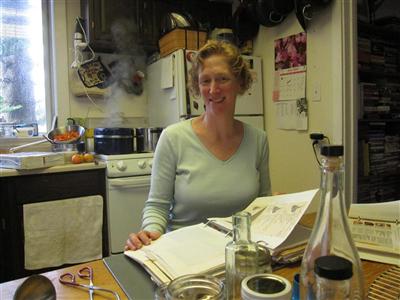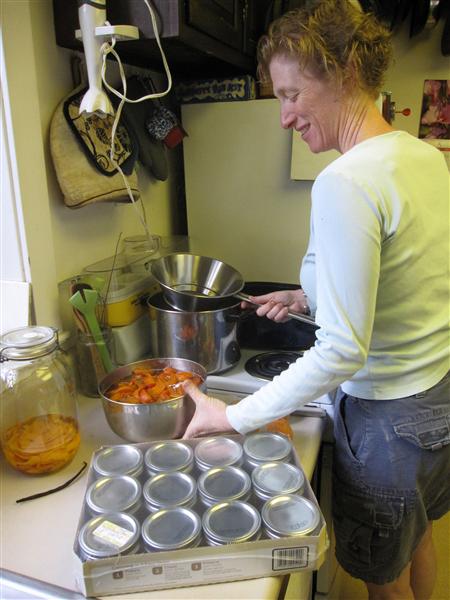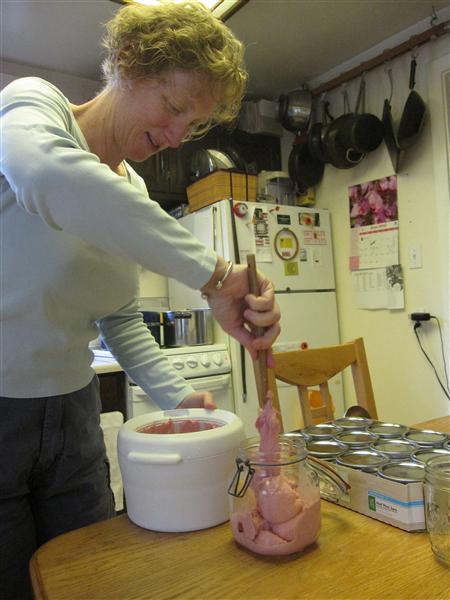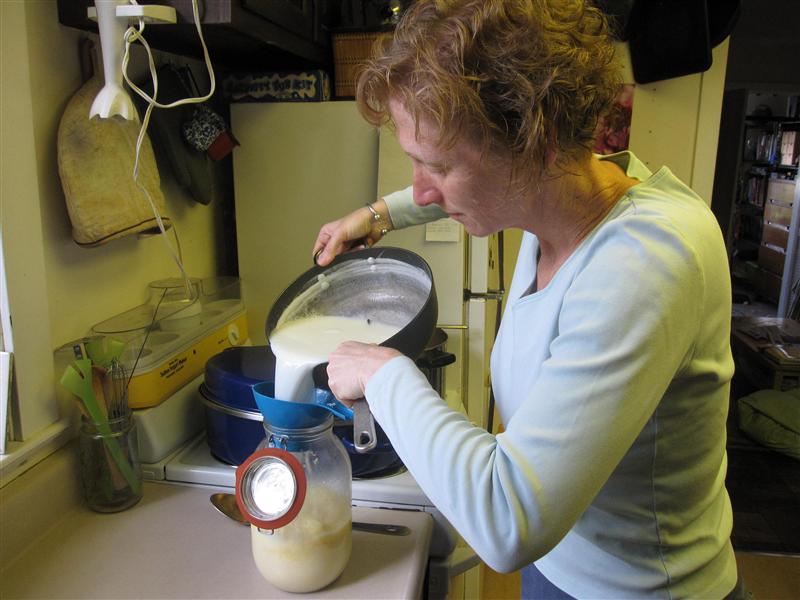
RETURN TO HOME PAGE
FEEDBACK
 |
July-August 2010 RETURN TO HOME PAGE FEEDBACK |
By Olivia Boler
Elizabeth Crane is making bread in her Eureka Street cottage kitchen. The electric mixer is whirring away as she opens a jar of her homemade apricot jam and scoops out a dollop for a visiting reporter.

Elizabeth Crane has been “jamming” all her life, but she often turns to books like Stocking Up for recipes on canning and preserving. Photos by Pamela Gerard "Try this," says Crane, who besides being an avid cook is the manager of the Noe Valley Farmers' Market on 24th Street. "I give it to friends as Christmas gifts, and they tell me that when they pop open the lid, it's like summer in a jar."
This reporter would have to wholeheartedly agree, and so did the judges at the San Francisco Giants' "Urban Eats" County Fair, a celebration of homemade foods held at McCovey Cove in mid-June. Crane's apricot jam won the blue ribbon in the "Preserved Foods" cooking competition.
"I've never entered a jam contest before, so to go home with the gold was pretty cool," says Crane, 45.
Crane, who grew up in southern California's Seal Beach, has been jamming, or rather canning, since she was 11. "Canning is any kind of preservation of food in a jar or can to make it shelf-stable so it doesn't go bad," she explains. "Jamming," or making jam from fruit, is a subcategory. It involves pouring fresh fruit mixed with sugar into glass jars sterilized in boiling water.
Crane's first jam was from her mother's fig tree. She combined the figs with Meyer lemons. "I hated it," she says of the taste. "What did I know? I was 11! Now I'd kill for it."
Instead, she made metaphorical lemonade out of those Meyer lemons by selling the jam with an ad in Leisure World Circular, a local publication that targeted senior citizens. "My mom drove me in her VW van to deliver these jars of jam for 50 cents."
Her mother also taught by example. "She was a child of the Depression. She made everything, like succotash and bread and butter pickles." For Crane's mother, canning was a matter of necessity during hard times. But when prosperity returned, like most of her generation, she opted for buying mass-produced foods at the supermarket. "The idea of putting up your own stuff--well, why would you when you can just go into the store and take it off the shelf?"
But for Crane, the benefits of home canning--health, thriftiness, and mouth-watering pleasure--far outweigh the hours she might spend in the kitchen.
"I like to know what's in my food," she says. "Also, there's the satisfaction of doing something yourself. And how great is it to be able to give away these jars of jam? People always appreciate it. You can't buy that, and I value it."
Crane has been up to her elbows in food all her life. In addition to her mother, she credits her older sister Ann, who owns her own catering company in southern California, with instilling in her a love of food and cooking. "When I was in high school, my sister would come home on the weekends from college and cook. One Thanksgiving, we made this feast. The turkey wore a bow tie and spats. It was very Martha Stewart from the 1980s, very precious," she laughs.
Crane attended college in Philadelphia and worked for caterers there as well as in New York and San Francisco. For about 10 summers starting in 1994, she sold peaches at the Ferry Building farmers' market for Fitzgerald's Orchard of Reedley, Calif. These days, she's busy parenting two teenage boys--with husband Richard Raucci--and working as a ghostwriter. "I'm ghosting a blog, doing some copyediting, and some research for another writer."
But her juiciest weekend pastime is as the only paid employee for the Farmers' Market, which was started by neighborhood volunteers in 2004. She sets up and breaks down the stalls, collects fees, and makes sure all runs smoothly. "Being the manager mostly means showing up and being the face in the place," Crane says. "In about 300 Saturdays, I've hardly missed any. I love it."
With all that access to fresh fruit and vegetables, she rarely buys produce from grocery stores, occasionally making a run to Rainbow Grocery (also the place to buy glass jars and lids for the beginning canner, she says). "I get what's in season, and as the Farmers' Market manager, I get great deals. Why would I shop anywhere else?"
Although she has a lovely garden with a lemon tree, herbs, and flowers, Crane says she has "black thumbs." But she doesn't mind taking advantage of those who can garden. One of her neighbors has seven plum trees, so each year, Crane makes about ten jars of plum jam, giving back three to the trees' owner and keeping the rest.
A self-proclaimed "stone fruit snob," Crane also makes lemoncello--"it's lemon booze"--and a variation made with oranges, orangecello. She pulls a mason jar of a thick, creamy substance from her freezer--a lemoncello crema, which is milk-based. "I like it slushy and cold. People go crazy for it."
As for her award-winning jam recipe, Crane says it was inspired by Bread and Chocolate: My Food Life in and around San Francisco, a book in which author Fran Gage extols the virtues of making jam, among other foods. Gage's jam-making process takes several days, but Crane has narrowed it down to two. She's also cut down on the ratio of sugar to fruit--from equal parts to one part sugar and four parts fruit (see recipe).
The classic preservation guide Stocking Up is another book Crane leans on. "I haven't read it [cover to cover], but I open it to certain sections. It will tell you how to can absolutely everything."
Crane insists that making jam is "not hard. It's all about the ingredients and the process. If I was talking to someone new to canning, I'd say find a mentor. There's no better way to learn than by following someone around."
She says that if readers want to come talk to her about jamming, they can track her down at the Farmers' Market, which runs 8 a.m. to 1 p.m. each Saturday, on 24th Street near Vicksburg.
Meanwhile, they might stir up one of the three recipes that Crane has shared with the Voice. Trust this reporter--the results are delicious.
Recipes from the Kitchen of Elizabeth Crane
Apricot Jam

Elizabeth Crane lines up jars for her prize-winning apricot jam. Photos by Pamela Gerard My recipes tend to be a little vague. I don't measure things exactly, and I am prone to telling people to "cook it till it's done." What follows is my best approximation of ingredients and approach for making apricot jam [which just won the blue ribbon at the San Francisco Giants "Urban Eats" County Fair]. --Elizabeth Crane
Day One. Take five pounds of apricots. Make sure they're not overripe. Wash them and cut them into fat slices. (Depending on the size of the fruit, that's either quarters, sixths, or eighths.) When you slice, remove any dark spots, blemishes, or rotten parts. Also, try to remove the stringy bit that holds the pit onto the fruit. Slice into a four-cup measuring bowl.
Layer the sliced fruit in a large stainless bowl or pot with sugar. I use a ratio of about 4:1 fruit to sugar, but if the fruit is particularly tart, I use more sugar. The method is: cut the fruit to fill the measuring cup, dump the fruit in the large stainless bowl, pour in the sugar, repeat.
Once all the apricots are layered, gently shake the fruit/sugar mixture to settle the sugar around the slices. Leave the bowl on the counter for a few hours. When you come back to it, gently turn the contents with a rubber scraper. You will notice that the sugar is dissolving and the fruit is getting soft. Try to eliminate any visible grains of sugar by stirring. Then cover and refrigerate.
Day Two. Strain the juice from the solids. In a large stainless pot (8 quart), boil the juice until it gets a little thick and reduces by about half, then add the solids to the pot. Do this very carefully--you do not want to be splashed with hot sugar syrup. Bring the contents to a boil, then cook till it looks like jam (about 20 minutes), stirring frequently to prevent scorching.
In the meantime, assemble your jars, lids, boiling water, tongs, and canning funnel. Boil the jars in a large shallow pan (I use a roasting pan).
To fill a jar, lift it from the water with the tongs, gently shake it dry, and place it on a clean section of your work surface. Scoop out some jam from the pot and ladle it carefully into the jar (use the funnel here if you have one).
Fill to the ridge of glass below the threads that hold on the lid (look at a canning jar, you will immediately see where I mean--it's about half an inch from the top of the glass). Wipe the rim and threads clean with a damp paper towel in case you spilled any jam.
Drop a two-part canning lid into the boiling water for a few moments, then lift it out and seal the jar "fingertip tight" (no need to tighten like crazy). Set the jar aside on a rack to cool. (Yes, it's hot, but I am used to handling them and do not need hot pads. You might.) Start with the next jar and repeat. Listen out for the popping sound that means the jar has sealed itself successfully.
Five pounds of apricots makes about 10 half-pint jars of jam.
Roasted Strawberry Frozen Yogurt

Crane spoons strawberry frozen yogurt from the bowl of her Krups ice cream maker. I have an electric Krups ice cream maker that my husband got at a thrift store. You have to put the bowl part of it in the freezer well ahead of making the ice cream, so what I do is put it in the freezer when I make the mixture on Day One. Then I refrigerate the mix until the bowl is cold enough to use--about 24 hours.
2 pints organic strawberries
(it's okay if the berries are a little over the hill)1/2 cup sugar
2 tablespoons booze
1 teaspoon vanilla
1 pint plain yogurt
1/2 cup cream
Day One. Heat your oven to 400 degrees. Wash and remove the greens from the strawberries. Place them in a glass roasting pan and into the oven for about 15 minutes until they get a little squishy and start to smell wonderful.
Using a wooden paddle, mash the strawberries in the pan, moving them around so you dissolve all the caramelized juices in the pan (you want all that in your ice cream). Push the strawberries through a strainer into a medium bowl, making sure to scrape all the juice from the pan. Discard the pulp and seeds.
To the strawberry puree in your bowl, stir in the sugar to dissolve. Add the yogurt, cream, vanilla, and booze (I use vodka or cherry liqueur, whatever I have on hand--the point is to have something in there that prevents the ice cream from freezing as solid as a brick). Pour the mixture into a quart container to chill overnight. If the container is not close to full, add a little more cream.
Day Two. Following the instructions for your ice cream freezer, churn the mixture into ice cream. Store the results in your freezer.
Orangecello
This is a variation on Limoncello, the delicious lemon liqueur from Italy. As with all my recipes, measurements are provided as guidelines, not as hard and fast rules.
6 to 8 large organic oranges
750 ml Everclear grain alcohol
2 quarts whole milk
2 cups sugar
1 vanilla bean
Day One. Wash the oranges and remove all of the rind with a potato peeler. Place the orange strips in a large (3 liter) glass jar and pour in the Everclear. Seal and put in a dark place for a few weeks, taking it out occasionally to shake it around and sniff it.
Day 25 or so. In a large saucepan, bring the milk almost to a boil. Stir in the sugar and vanilla bean and allow to cool. Discard the orange peels and add the milk mixture to the Everclear (which is now a nice orange color). Close the jar and put it in the fridge.
You can drink this now or you can let it mellow. The longer it sits, the better the flavor. After a few weeks I stir it up, discard the vanilla bean, and decant the liquid into quart jars, most of which I put in the freezer and one in the fridge (for drinking).

Crane’s “orangecello crema” is an orange cream liqueur modeled after the Italian limoncello.
Cookbooks on Canning
Samantha Tackeff, store manager at Omnivore Books at the corner of Church and Cesar Chavez, says Elizabeth Crane's enthusiasm for jamming is shared by many others in Noe Valley.
"There's absolutely a trend. Books on preserving food have been wonderful sellers since we opened our doors over a year ago," says Tackeff. Customers are asking for guides to pickling, canning, and preserving. "In California, things grow year-round, so people are preserving food all the time."
Tackeff notes that a lot of customers grow their own foods--"they'll come in and tell us about their lemon tree just overflowing with fruit." Otherwise, they pick up their produce at local farmers' markets like the one on 24th Street.
To help the novice, Tackeff suggests this list of books on jamming and canning. "We also have some really great vintage books on the subject, too."
* Jam It, Pickle It, Cure It: And Other Cooking Projects, by Karen Solomon. ("Karen lives on Dolores Park," Tackeff says.)
* The River Cottage Preserves Handbook by Pam Corbin and Hugh Fearnley-Whittingstall. ("This is a book from the UK that just got released here in the States," says Tackeff. "I really love it.")
* The Joy of Pickling and The Joy of Jams, Jellies, and Other Sweet Preserves, by Linda Ziedrich
* Well-Preserved: Recipes and Techniques for Putting Up Small Batches of Seasonal Foods by Eugenia Bone
Tackeff also offers this tip for busy "jammers": You don't always need to make sealed jars of jam. "You can make refrigerator jam. Right now the strawberries are so good, and when we make that jam, those jars get eaten really fast."